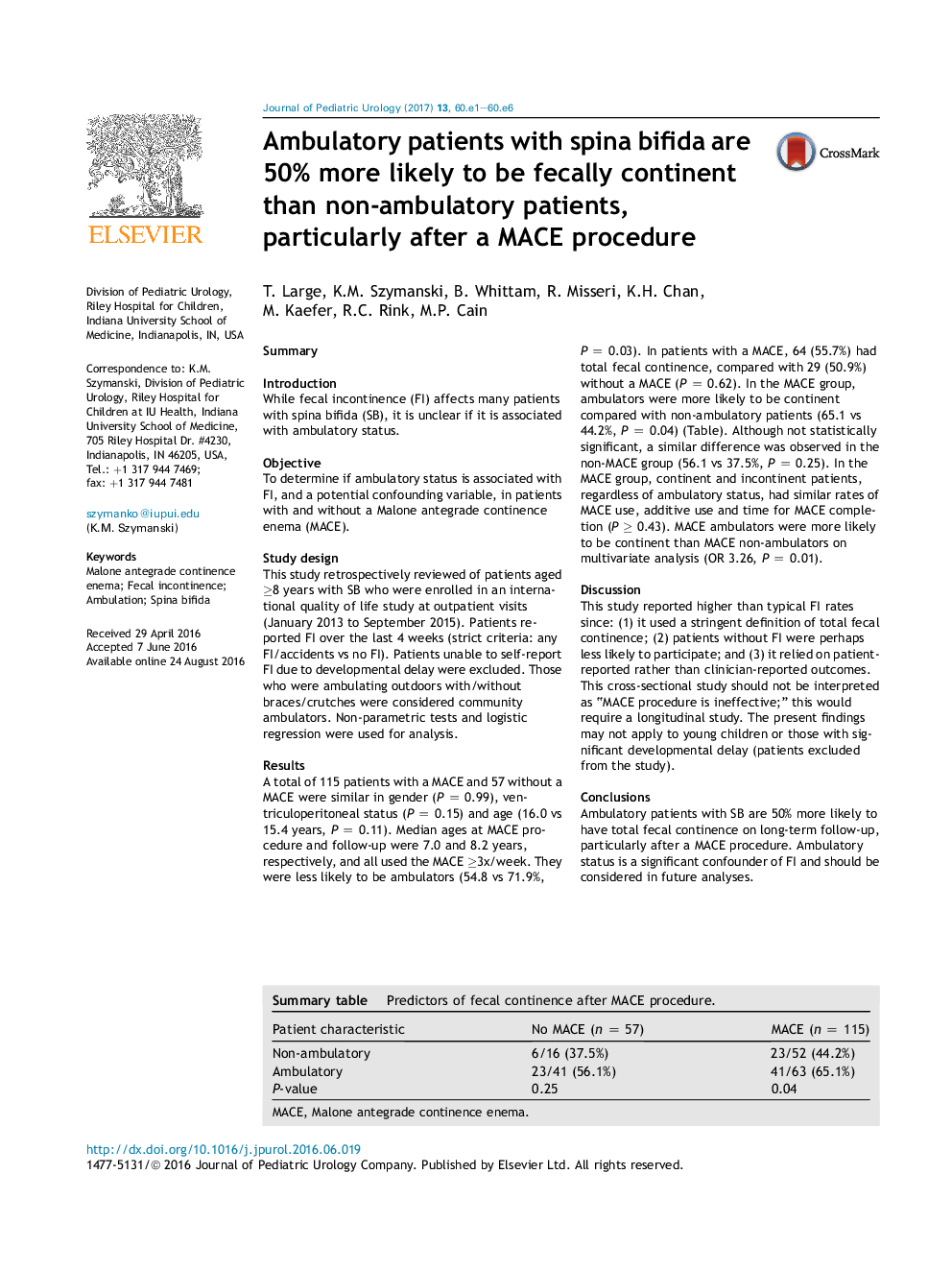| کد مقاله | کد نشریه | سال انتشار | مقاله انگلیسی | نسخه تمام متن |
|---|---|---|---|---|
| 5718663 | 1411255 | 2017 | 6 صفحه PDF | دانلود رایگان |

SummaryIntroductionWhile fecal incontinence (FI) affects many patients with spina bifida (SB), it is unclear if it is associated with ambulatory status.ObjectiveTo determine if ambulatory status is associated with FI, and a potential confounding variable, in patients with and without a Malone antegrade continence enema (MACE).Study designThis study retrospectively reviewed of patients aged â¥8 years with SB who were enrolled in an international quality of life study at outpatient visits (January 2013 to September 2015). Patients reported FI over the last 4 weeks (strict criteria: any FI/accidents vs no FI). Patients unable to self-report FI due to developmental delay were excluded. Those who were ambulating outdoors with/without braces/crutches were considered community ambulators. Non-parametric tests and logistic regression were used for analysis.ResultsA total of 115 patients with a MACE and 57 without a MACE were similar in gender (P = 0.99), ventriculoperitoneal status (P = 0.15) and age (16.0 vs 15.4 years, P = 0.11). Median ages at MACE procedure and follow-up were 7.0 and 8.2 years, respectively, and all used the MACE â¥3x/week. They were less likely to be ambulators (54.8 vs 71.9%, P = 0.03). In patients with a MACE, 64 (55.7%) had total fecal continence, compared with 29 (50.9%) without a MACE (P = 0.62). In the MACE group, ambulators were more likely to be continent compared with non-ambulatory patients (65.1 vs 44.2%, P = 0.04) (Table). Although not statistically significant, a similar difference was observed in the non-MACE group (56.1 vs 37.5%, P = 0.25). In the MACE group, continent and incontinent patients, regardless of ambulatory status, had similar rates of MACE use, additive use and time for MACE completion (P â¥Â 0.43). MACE ambulators were more likely to be continent than MACE non-ambulators on multivariate analysis (OR 3.26, P = 0.01).DiscussionThis study reported higher than typical FI rates since: (1) it used a stringent definition of total fecal continence; (2) patients without FI were perhaps less likely to participate; and (3) it relied on patient-reported rather than clinician-reported outcomes. This cross-sectional study should not be interpreted as “MACE procedure is ineffective;” this would require a longitudinal study. The present findings may not apply to young children or those with significant developmental delay (patients excluded from the study).ConclusionsAmbulatory patients with SB are 50% more likely to have total fecal continence on long-term follow-up, particularly after a MACE procedure. Ambulatory status is a significant confounder of FI and should be considered in future analyses.Summary table. Predictors of fecal continence after MACE procedure.Patient characteristicNo MACE (n = 57)MACE (n = 115)Non-ambulatory6/16 (37.5%)23/52 (44.2%)Ambulatory23/41 (56.1%)41/63 (65.1%)P-value0.250.04MACE, Malone antegrade continence enema.
Journal: Journal of Pediatric Urology - Volume 13, Issue 1, February 2017, Pages 60.e1-60.e6